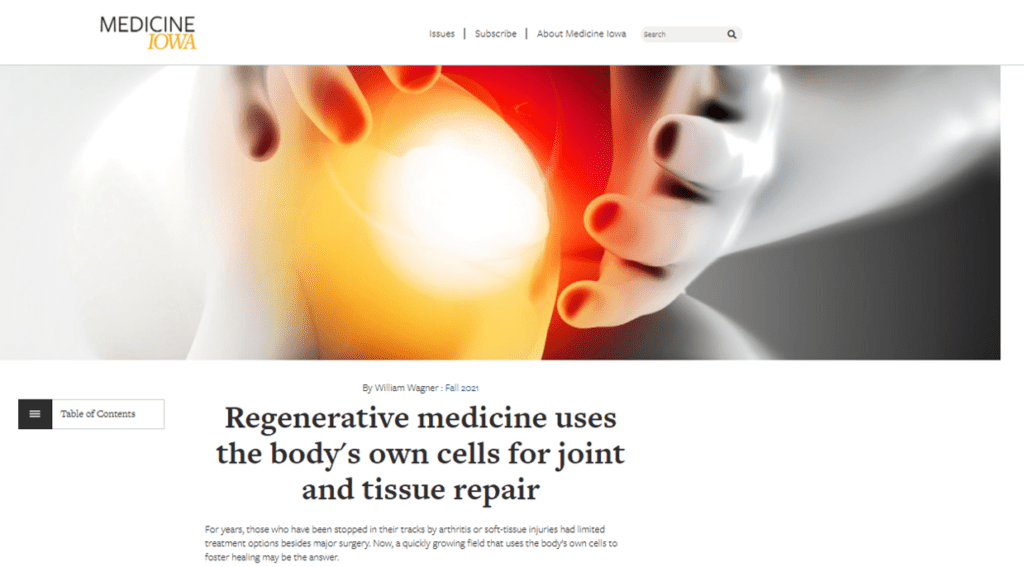Is Academia Leading or Trailing Private Practice in the Field of Orthobiologics?

Credit: Shutterstock
In many areas of medicine, you go to an academic Medical Center if you have a rare condition. However, in orthobiologics, it’s been the opposite in that there is more accumulated experience and published data in private practices. This morning I’ll review why that is and how academia stacks up. Let’s dig in.
Academia and Rare Conditions
All of us have an experience of a loved one with a rare medical condition who travels to some famous academic Medical Center to get treated. This makes sense, as large academic Medical Centers act as collectors for rare diseases and thus the doctors that work there have seen more of those unusual cases than anyone else. However, there are some caveats to that rule which we’ll explore this morning.
The Outside the Box Caveat
If you have a medical problem that’s inside the traditional medicine box, a large academic Medical Center is the right spot. However, if your problem is not well represented in traditional medicine or you’re looking for treatments that are less aggressive, then these centers are often the opposite of where you should be.
Let’s take for example the diagnosis of Craniocervical Instability (CCI or damage to the ligaments that hold the head on). If you want a surgical option, you can usually find a neurosurgeon at an academic Medical Center who can fuse your upper neck. However, the surgeons with the most experience in this surgery (i.e. the highest number of cases under their collective belts) are mostly in private practice. If you want to find a less aggressive alternative involving orthobiologics, there are no academic Medical Centers that will be able to help, as the only solutions are again in private practice.
The Academic Orthobiologics Dilemma
The example above brings up an important point. When it comes to Platelet-Rich Plasma, Bone Marrow Concentrate, and Mfat used to treat orthopedic conditions (orthobiologics), academics are more behind right now than out in front.
Why? Two reasons-institutional pushback and money. Let’s explore both.
Many academic physicians I know have tried hard to add orthobiologics to their practices. They began expressing an interest about 10 years ago but were met with pushback from orthopedic surgeons within their institutions. This was more due to the fact that many academic Medical Centers are fiercely territorial. The surgeons simply didn’t want non-surgeons treating orthopedic patients that were otherwise surgical candidates. The good news is that because of an explosion of presentations about orthobiologics at orthopedic conferences, this pushback is quickly eroding.
The second issue was money. While most of us think that academic medicine is money agnostic, it’s quite the opposite. Most academic Medical Centers are run as businesses. However, the ability and infrastructure to charge patients directly for procedures not covered by insurance were just not there. For example, I remember a prolonged conversation with an academic physician who wanted to add PRP to his practice. It took him several years of negotiating with the bureaucracy to finally find the right codes to use so that he could be compensated and his department was satisfied.
Academia and Orthobiologics
All of these roadblocks have slowed down the ability of academic physicians to add orthobiologics. However, as the evidence base for these procedures has improved, the pressure for academic physicians to keep up with their colleagues in private practice has increased. Hence, over the last 3-5 years, for the most part, these log jams have been broken by the hard work of a handful of key academic physicians. That resulted in a domino effect, so we now have orthobiologics starting to be embraced by academia, and institutions from Harvard to Stanford, to Mayo are now offering PRP, Bone Marrow Concentrate, and Micro-fragemented fat (MFat) treatments.
However, all of this hard work to get these procedures into academic Medical Centers has resulted in a situation where most academic centers have been lapped a few times by their private practice colleagues. Let’s look at a case study in Iowa. Recently this news story appeared:

Credit: Iowa Medicine a publication of the University of Iowa Health System
This is the University of Iowa Healthcare system’s newsletter. First, it’s great to see that this university is embracing orthobiologics, in this case, the use of platelet-rich plasma (PRP) and MFat to treat orthopedic problems. They’ve even recruited a fine young physician, Ryan Kruse, M.D. to head this effort.
So let’s examine whether the University of Iowa is leading or following. Way back in 2014, Regenexx opened a site using orthobiologics in Des Moines and began tracking the clinical outcomes of these Iowa patients in a registry. That site currently uses the best evidence treatments which are platelet-rich plasma (PRP) and bone marrow concentrate. In that 7 years, we’ve published dozens of peer-reviewed papers on the use of orthobiologics in orthopedic injuries. Some of those were sourced from our registry data and some through specific studies like randomized controlled trials. In addition, we also heavily mined that data to see who was a good candidate for various procedures and who was not. All of that lead to contracts with over 500 companies to offer orthobiologics as a covered benefit, a chunk of those contracts in Iowa.
Now in 2021, the above article describes that the University of Iowa is now:
- Beginning to collect orthobiologics outcome data in a registry
- Using PRP and MFat
It’s wonderful to see that the University of Iowa is finally using orthobiologics and collecting data, some 7 years after a local private practice did the same things it’s currently doing now.
In the article, the following statement is made, “Kruse says the UI offers the only evidence-based regenerative medicine practice in Iowa and is part of several ongoing studies measuring variables such as outcomes and side effects.” Is this statement accurate? Nope. Again, Regenexx Des Moines has been an evidence-based practice since 2014 and our company has collected published more clinical data on orthobiologics than the University of Iowa could collect or publish in the next decade.
Again, this is not to shed a negative light on the University of Iowa. It’s critical for the adoption of orthobiologics that they and other universities continue adopting orthobiologics to treat patients. However, they are following now rather than leading. Will they eventually take the lead? Time will tell.
On that note, we’re seeing great things out there from other universities. For example, the Emory program in Atlanta has embarked on a large randomized controlled trial of BMC vs. MFat vs. SVF to treat knee OA. These results, when published, will be a huge help to the field and for this Emory is to be congratulated.
The upshot? The more the merrier! We want more and more universities to enter the clinical treatment and research world in orthobiologics. We also hope that more universities move from the position of following private practice to helping co-lead the field.

NOTE: This blog post provides general information to help the reader better understand regenerative medicine, musculoskeletal health, and related subjects. All content provided in this blog, website, or any linked materials, including text, graphics, images, patient profiles, outcomes, and information, are not intended and should not be considered or used as a substitute for medical advice, diagnosis, or treatment. Please always consult with a professional and certified healthcare provider to discuss if a treatment is right for you.
